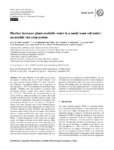Use este identificador para citar ou linkar para este item:
http://www.alice.cnptia.embrapa.br/alice/handle/doc/1011709Registro completo de metadados
| Campo DC | Valor | Idioma |
|---|---|---|
| dc.contributor.author | CARVALHO, M. T. de M. | pt_BR |
| dc.contributor.author | MAIA, A. de H. N. | pt_BR |
| dc.contributor.author | MADARI, B. E. | pt_BR |
| dc.contributor.author | BASTIAANS, L. | pt_BR |
| dc.contributor.author | VAN OORT, P. A. J. | pt_BR |
| dc.contributor.author | HEINEMANN, A. B. | pt_BR |
| dc.contributor.author | SILVA, M. A. S. da | pt_BR |
| dc.contributor.author | PETTER, F. A. | pt_BR |
| dc.contributor.author | MARIMON JUNIOR, B. H. | pt_BR |
| dc.contributor.author | MEINKE, H. | pt_BR |
| dc.date.accessioned | 2015-03-18T11:11:11Z | pt_BR |
| dc.date.available | 2015-03-18T11:11:11Z | pt_BR |
| dc.date.created | 2015-03-18 | pt_BR |
| dc.date.issued | 2014 | pt_BR |
| dc.identifier.citation | Solid Earth, Göttingen, v. 5, p. 939-952, 2014. | pt_BR |
| dc.identifier.uri | http://www.alice.cnptia.embrapa.br/alice/handle/doc/1011709 | pt_BR |
| dc.description | The main objective of this study was to assess the impact of biochar rate (0, 8, 16 and 32 Mg ha-1) on the water retention capacity (WRC) of a sandy loam Dystric Plinthosol. The applied biochar was a by-product of slow pyrolysis (~450 °C) of eucalyptus wood, milled to pass through a 2000 micrometers sieve that resulted in a material with an intrinsic porosity less than or equal to 10 micrometers and a specific surface area of ~3.2 m2 g-1. The biochar was incorporated into the top 15 cm of the soil under an aerobic rice system. Our study focused on both the effects on WRC and rice yields 2 and 3 years after its application. Undisturbed soil samples were collected from 16 plots in two soil layers (5-10 and 15-20 cm). Soil water retention curves were modelled using a nonlinear mixed model which appropriately accounts for uncertainties inherent of spatial variability and repeated measurements taken within a specific soil sample. We found an increase in plant-available water in the upper soil layer proportional to the rate of biochar, with about 0.8% for each Mg ha-1 biochar amendment 2 and 3 years after its application. The impact of biochar on soil WRC was most likely related to an effect in overall porosity of the sandy loam soil, which was evident from an increase in saturated soil moisture and macro porosity with 0.5 and 1.6% for each Mg ha-1 of biochar applied, respectively. The increment in soil WRC did not translate into an increase in rice yield, essentially because in both seasons the amount of rainfall during the critical period for rice production exceeded 650 mm. The use of biochar as a soil amendment can be a worthy strategy to guarantee yield stability under short-term water-limited conditions. Our findings raise the importance of assessing the feasibility of very high application rates of biochar and the inclusion of a detailed analysis of its physical and chemical properties as part of future investigations. | pt_BR |
| dc.language.iso | eng | eng |
| dc.rights | openAccess | eng |
| dc.subject | Biocarvão | pt_BR |
| dc.title | Biochar increases plant-available water in a sandy loam soil under an aerobic rice crop system. | pt_BR |
| dc.type | Artigo de periódico | pt_BR |
| dc.date.updated | 2015-03-18T11:11:11Z | pt_BR |
| dc.subject.thesagro | Carvão | pt_BR |
| dc.subject.thesagro | Arroz | pt_BR |
| dc.subject.thesagro | Retenção de água no solo | pt_BR |
| dc.subject.thesagro | Solo arenoso | pt_BR |
| dc.subject.thesagro | Oryza Sativa | pt_BR |
| dc.subject.nalthesaurus | Biochar | pt_BR |
| dc.subject.nalthesaurus | Rice | pt_BR |
| dc.subject.nalthesaurus | Soil water retention | pt_BR |
| dc.subject.nalthesaurus | Sandy loam soils | pt_BR |
| riaa.ainfo.id | 1011709 | pt_BR |
| riaa.ainfo.lastupdate | 2015-03-18 | pt_BR |
| dc.identifier.doi | 10.5194/se-5-939-2014 | pt_BR |
| dc.contributor.institution | MARCIA THAIS DE MELO CARVALHO, CNPAF; ALINE DE HOLANDA NUNES MAIA, CNPMA; BEATA EMOKE MADARI, CNPAF; LAMMERT BASTIAANS, Wageningen University; PEPIJN A J VAN OORT, Wageningen University; ALEXANDRE BRYAN HEINEMANN, CNPAF; MELLISSA ANANIAS SOLER DA SILVA, CNPAF; FABIANO ANDRE PETTER, UFMT; B H MARIMON JUNIOR, UFMT; H MEINKE, Wageningen University. | pt_BR |
| Aparece nas coleções: | Artigo em periódico indexado (CNPAF)  | |
Arquivos associados a este item:
| Arquivo | Descrição | Tamanho | Formato | |
|---|---|---|---|---|
| CNPAF2014se.pdf | 1.56 MB | Adobe PDF |  Visualizar/Abrir |









